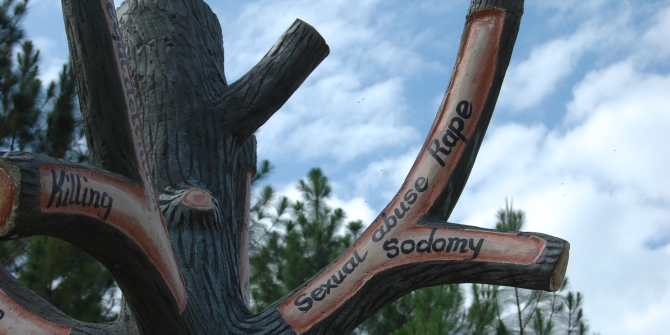In wartime, child soldiers are especially vulnerable to sexual violence. Policy and academic research portrays girls as the predominant victims of such violence with men as the perpetrators, but the reality on the ground is more complex. Especially in contexts of war where gender roles are complicated, boys and girls are shown to be both victims and perpetrators.
The phenomenon of the ‘child soldier’ has gathered much pace over the last twenty years, fuelling widespread media reporting as well as becoming a policy priority in the humanitarian field. In international policy discourse, a child soldier is defined as any child under the age of eighteen, who has been recruited or used by an armed force or armed group. The central argument of the international discourse is that children should not take part in war and that child soldiering is a violation of children’s universal rights.
Consequently, humanitarian organisations have advocated for legal instruments that prohibit the military recruitment of children and call for the adults that recruit them to be held criminally responsible. This is rooted in our preconceived notions of what constitutes a child and how they should be treated. We invariably draw comparisons with our own understanding of childhood, which is swathed in innocence and vulnerability.
The assumption that most child soldiers are victims is commonplace, and there is an almost universal rejection of the possibility that a child soldier is an active agent. This is especially the case for girl soldiers, who are frequently portrayed as bush wives and sex slaves. There has been a proliferation of research into girl soldiers and sexual and gender-based violence as being fundamental to their experiences.
The use of sexual violence in times of war and in the transitions to peace is well documented, where child soldiers are exposed to it as both victims and perpetrators. It is considered an inevitable consequence of war and conflict, a result of militarised hegemonic masculinity, which is embedded in pre-conflict norms and values of gender inequality in a given society.
Within this climate, male victimisation is underreported, and there is very little systematic data on male victims of sexual violence, which is especially the case with regard to boy soldiers. Indeed, male victims of sexual violence have been defined as the ‘last human rights taboo’. However, this form of violence can be either male on male or even perpetrated by women and girls.
There is a misconception that women and girls are inherently peaceful, and girl soldiers committing acts of sexual violence is overlooked in legal instruments, disarmament, demobilisation and reintegration (DDR) programming and widespread media reporting. Instead, the predominant discourse holds that sexual violence is almost exclusively perpetrated against women and girls. The assumption that women and children are incapable of committing certain acts of violence leads to the idea that men are its sole perpetrators.
Gender theory has long contested the dichotomy of ‘male’ and ‘female’, in which characteristics accompany each category such that men are more ‘aggressive’ while women are ‘nurturing’. A significant body of feminist literature challenges the conceptions of ‘sex’ and ‘gender’ as being too often inappropriately viewed as interchangeable: rather, ‘sex’ refers to biological characteristics and ‘gender’ as the social expectations linked with the biological sex of a person.
It is well understood that the category of ‘female’ and ‘male’ cannot be viewed exclusively through the prism of two biological/chromosomal configurations but instead social constraints, social expectations and social power as opposed to innate, essential fundamental differences. In this regard, the idea that ‘men’ are perpetrators and ‘women’ victims is reductive and oversimplified. War and conflict complicates rather than simplifies gender roles, and to regard women as capable active agents and men as frequently feminised in acts of violence demonstrates the ambiguity of the sexual identity construct.
Portrayals of sexual violence are often framed using cultural and sexual stereotypes which see men as being sexually dominant and women as passive victims, rendering the space for men to share their experiences all the more difficult. This is further compounded by an understanding of masculinities and femininities framed within a global discourse where gendered experiences globally are understood through the prism of a western, neo-colonial perspective. African bodies are portrayed as violent, and in need of discipline and saviour. We are confronted with depictions of ‘third world women’ who desperately need rescuing from evil male perpetrators.
It is important to understand the gendered dynamics of boy and girl soldier experiences and how they consolidate and operate multiple identities in war and conflict, viewing these experiences as hierarchical rather than binary. Gender is a way of organising, categorising and symbolising power, of hierarchically structuring relationships among categories of people who are symbolically associated with masculinity and femininity. It is a structural power relation that relies upon certain distinctions among categories of people, regarding some as more important than others.
All systems of power in armed conflict are gendered, whether state institutions (from the health, security to justice sector) to non-state (development organisations, NGOs, civil society organisations, customary law, traditions and families). These institutions shape how men, women, girls and boys experience, negotiate and attempt to survive conflict and disaster. They are not only grounded in certain ideas about gender, but they also help to reproduce and reinforce what constitutes appropriate gendered behaviours.
Discursive practices rely heavily on universal binary oppositions of childhood/adulthood, innocent/guilty, victim/perpetrator, passive/active, male/female and so on. Such oppositions must be acknowledged and renegotiated to better facilitate cooperation between international organisations and communities. For child soldiers, there is no linear trajectory from victim to perpetrator; instead children are situated in a hazy realm of victim and perpetrator.
Lacking in the policy and scholarly landscape are the voices of the child soldiers themselves. Their input is crucial to strengthening programming and accountability mechanisms. Any programme or project aimed at improving the lives of children should include them in the research and planning phase. It is essential that we move away from dominant discourses, representations, universal narratives and gender binaries towards an understanding of the diversity of lived experiences to better respond to conflict-related sexual violence and to prevent it in the future.
Photo: Former Sudanese internally displaced persons (IDPs) return to their homes in Swilinga village, Darfur. Credit: UN Photo, Albert Gonzalez Farran, licensed under Creative Commons (CC BY-NC-ND 2.0).






Hello. I am writing my master thesis with focusing to the concept of direct participation in hostilities. Do you believe this concept is also with gendered dynamic?